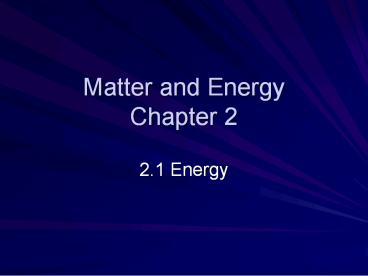Matter and Energy Chapter 2 - PowerPoint PPT Presentation
Title:
Matter and Energy Chapter 2
Description:
Matter and Energy Chapter 2 2.1 Energy Objective/Warm-Up Students will be able to apply their knowledge of density to a real world problem. How can you use density to ... – PowerPoint PPT presentation
Number of Views:85
Avg rating:3.0/5.0
Title: Matter and Energy Chapter 2
1
Matter and Energy Chapter 2
- 2.1 Energy
2
Objective/Warm-Up
- Students will be able to apply their knowledge of
density to a real world problem. - How can you use density to determine if something
will sink or float in water?
3
Energy Changes
- Energy the capacity to do work
- All physical and chemical changes involve changes
in E. - Endothermic describes a process in which heat
is absorbed from the environment
4
Energy Changes
- Exothermic describes a process in which a
system releases heat into the environment - NaOH H2O
- Evaporation the change of a substance from a
liquid to a gas
5
Law of Conservation of Energy
- Law of Conservation of Energy in a chem. or
phys. change, E is neither created nor destroyed - It can be transferred or converted
- Chemical, mechanical, light, sound, heat,
electrical
6
Energy
- Kinetic Energy the E a moving object has b/c of
its motion - Potential Energy the E an object has b/c of its
position
7
E Transfer
- In chemistry, the most common E transfer is in
the form of heat - Heat the energy transferred b/t objects that
are at different temps. - Temperature a measure of the average kinetic E
of the particles in a sample of matter.
8
Temperature Scales
9
Equations for Temp Conversions
- t (C) T(K) 273.15 K
- T(K) t (C) 273.15 C
- Convert 25 C to Kelvin
- T(K) 25 273.15 C 298.15 K
- Convert 1500 K to C
- t (C) 1500 273.15 K
- t (C) 1226.85 C
10
Specific Heat Capacity
- Specific Heat Capacity the amount of E required
to raise the temp of 1 gram of a substance by 1
Kelvin under constant T P - Different for each element
- Measured in J/gK joule is the SI unit for E
- Determined experimentally
11
Objective/Warm-Up
- Students will be able to calculate change in
temperature and specific heat capacity. - What do the terms endothermic and exothermic
mean? - How would you know that a reaction is endothermic
or exothermic?
12
Calculations-Specific Heat
- Q m c ?T
- Q heat energy (J)
- m mass (g)
- c specific heat (J/gK or J/goC)
- ?T change in temperature (T final T
initial) (K or oC)
13
Calculations
- Calculate the heat required to increase the
temperature of 15 g of aluminum by 10. K. The
specific heat of aluminum is 0.897 J/gK - Q 15g x 0.897J/gK x 10.K
- Q 134.55 J
- 130 J with sig figs
14
Calculations
- How much energy is given off when 25 grams of
lead cools by 25 K if the specific heat of lead
is 0.129 J/gK? - Q 80.625 J
- 81 J with sig figs
15
Objective/Warm-Up
- Students will be able to convert temperatures and
calculate heat capacity. - Warm-Up Concept Review worksheet
16
Mass and Energy
- Thought to be unrelated
- Emc2 relates mass and energy
- c is equal to the speed of light of 2.998 x 108
m/s - In a nuclear power plant, mass is converted to
energy
17
E mc2
- How much E is obtained from a 1.00 gram object?
- E mc2
- E 1.00 g x (2.998 x 108 m/s)2
- E 8.988 gm2/s2 or 8.988 x 1013 J
- Its enough to raise a burger to your mouth 90
trillion times
18
Assignment
- Do the section review on page 45. Do numbers
1-13.































